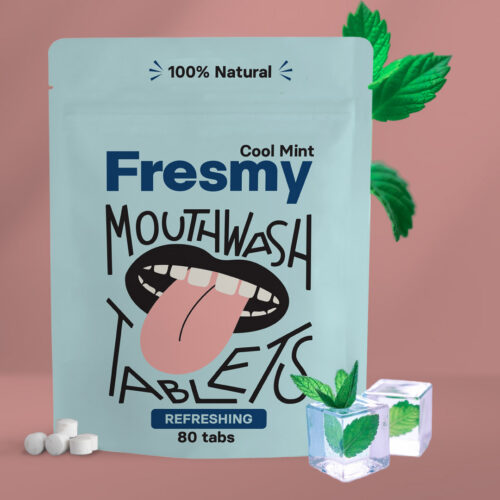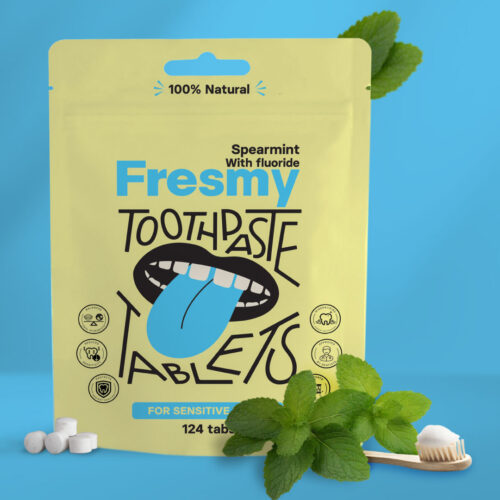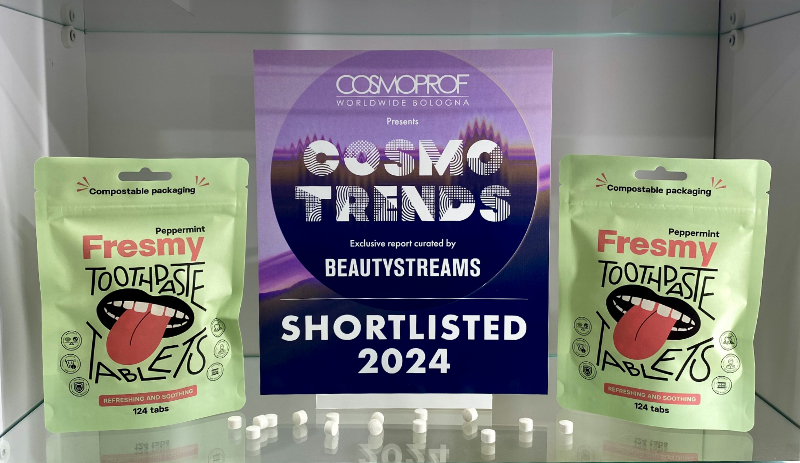Get ready to experience the next level in oral freshness and health – no negative side effects, dry mouth, or burning.
Are you tired of bulky mouthwash bottles, harsh chemicals, and the inconvenience of maintaining a fresh breath on the go? The world of oral hygiene is evolving, and we’re thrilled to announce a revolutionary new product that’s changing the game: Fresmy Mouthwash Tablets! Get ready to experience the next level in oral freshness and health – no negative side effects, dry mouth, or burning.

At Fresmy, we believe that oral care should be simple, natural, and effective. Our new mouthwash tablets are with natural ingredients, ensuring a non-toxic, alcohol-free, and fluoride-free experience that not only refreshes but actively enhances your oral health.
Why Fresmy Mouthwash Tablets are your oral health game-changer
Fresmy Mouthwash Tablets are a compact, powerful, and delightfully minty solution that brings convenience and targeted benefits to your daily routine.
Forget everything you thought you knew about traditional mouthwash. Fresmy Mouthwash Tablets are a compact, powerful, and delightfully minty solution that brings convenience and targeted benefits to your daily routine.
- Convenience Meets Innovation: Imagine carrying your mouthwash with you, effortlessly popping a tablet whenever you need a refresh – be it after a meal at work, before a meeting, or simply when you’re far from home. Fresmy tablets are travel-friendly and practical, making them the ultimate solution for on-the-go oral care. No leaky caps, no bulky bottles!
- Naturally Effective for a Healthier Smile: Fresmy Mouthwash Tablets are not just about fresh breath; they’re about building a stronger, healthier foundation for your teeth and gums. We’ve carefully selected best ingredients to deliver a comprehensive oral health solution:
-
- Hydroxyapatite (HAp): Your Enamel’s Natural Ally. At the heart of Fresmy lies Hydroxyapatite (HAp), a naturally occurring mineral that forms the primary component of your tooth enamel and bone. This incredible ingredient actively works to remineralize tooth enamel, helping to repair microscopic lesions and restore the tooth’s surface. What does this mean for you? Reduced tooth sensitivity and stronger teeth that are more resistant to decay. It’s like giving your teeth a natural shield, rebuilding them from within.
- Xylitol: The Sweet Defender Against Cavities. Another powerhouse ingredient in Fresmy is Xylitol (82%). More than just a natural sweetener, xylitol plays a crucial role in preventing cavities and significantly improving overall oral health. How does it work? Xylitol effectively reduces the growth of harmful bacteria in the mouth that cause plaque and cavities. It also helps to balance pH levels, creating an environment where beneficial bacteria can thrive while harmful ones struggle to survive. The result? Not only does xylitol contribute to incredibly fresh breath, but it actively supports stronger, healthier teeth.
- Beyond the Basics: Postbiotics and Vitamin B12 for Optimal Oral Health. Fresmy goes a step further by including postbiotics, which work to support oral health by creating a balanced oral microbiome. We’ve also added Cyanocobalamin (Vitamin B12), an essential vitamin for healthy gums and overall mouth wellness.

What you won’t find in Fresmy Mouthwash Tablets (and why that’s a good thing!):
Our dedication to natural and safe oral care means we’ve consciously excluded ingredients that can be detrimental to your health or simply unnecessary. Fresmy Mouthwash Tablets are:
- Alcohol-free
- Free from artificial colors
- Fluoride-free
- Non-toxic
- Gluten-free
- Vegan
Good to know: The mouthwash tablets are safe if accidentally swallowed. This makes them perfectly suitable for children who can already chew and rinse.
How to use mouthwash tablets that truly refresh
Using Fresmy Mouthwash Tablets is incredibly simple and extremely convenient:
- Chew the tablet:Gently chew one tablet until it starts to dissolve.
- Take a sip of water or use your saliva:Once the tablet begins to break down, take a small sip of water or simply use your saliva to activate the mouthwash.
- Swirl for 30 seconds and spit out the excess:Swish the solution vigorously around your mouth for at least 30 seconds to ensure all active ingredients reach every corner, then simply spit out the excess.
Tip! Fresmy Mouthwash Tablets are perfect for anytime use – after meals, before a meeting, or whenever you need a quick, cool refresh. They are the ultimate solution for both home and on-the-go oral care.
Allow the active ingredients to work!
After using the mouthwash tablets, you shouldn’t eat or drink for at least 30 minutes so that the active ingredients can take effect and all beneficial components can do their job.

Step into a fresher, healthier future with Fresmy!
Fresmy Mouthwash Tablets are more than just a new product; they’re a commitment to a healthier, more convenient, and natural approach to oral hygiene. Embrace the power of natural oral care, enjoy the long-lasting minty fresh breath, and build stronger, healthier teeth with every use.
Ready to revolutionize your oral care routine?





 Sweet peach-flavored toothpaste tablets for kids
Sweet peach-flavored toothpaste tablets for kids





 History of HAp
History of HAp What is nano-hydroxyapatite?
What is nano-hydroxyapatite?


 Why didn’t my package of toothpaste tablets arrive in the mailbox?
Why didn’t my package of toothpaste tablets arrive in the mailbox? One of the most important things to remember is that the mailbox must ensure the preservation of the mail and the owner or landlord of the building or apartment is responsible for its upkeep.
One of the most important things to remember is that the mailbox must ensure the preservation of the mail and the owner or landlord of the building or apartment is responsible for its upkeep. Mailbox requirements
Mailbox requirements




 Fresmy toothpaste tablets at the B2B trade fair Cosmoprof Worldwide Bologna
Fresmy toothpaste tablets at the B2B trade fair Cosmoprof Worldwide Bologna



